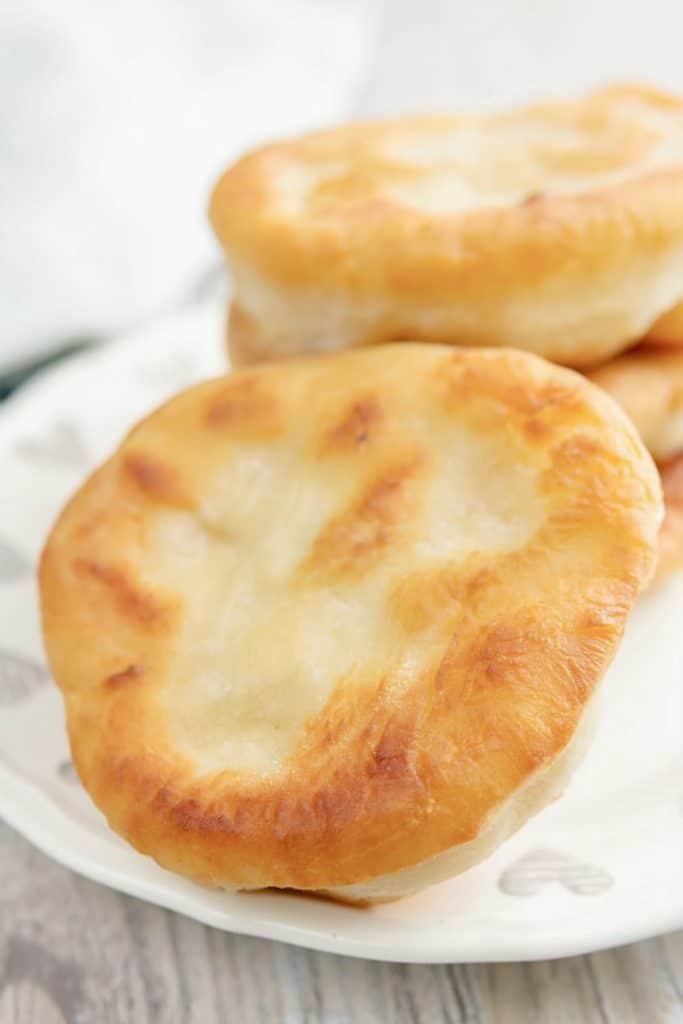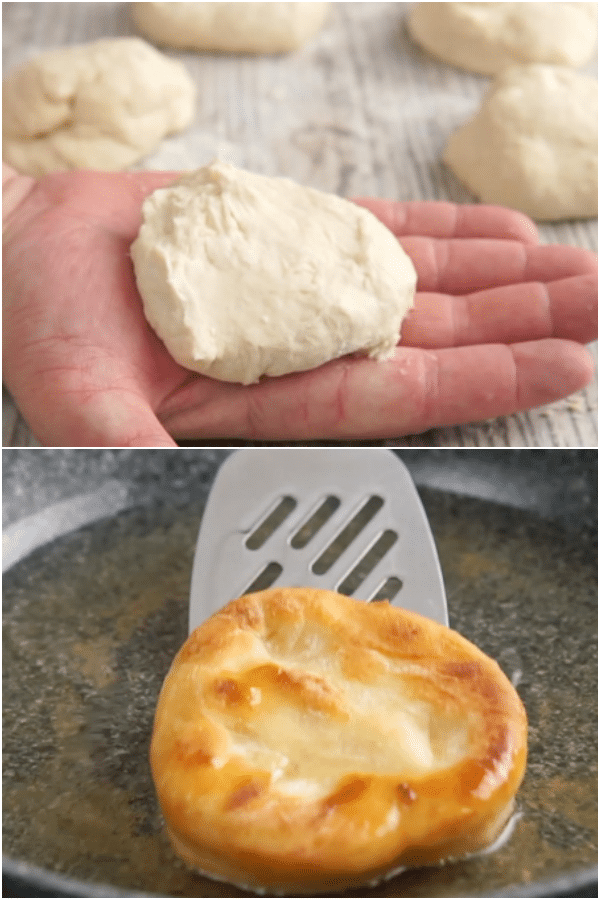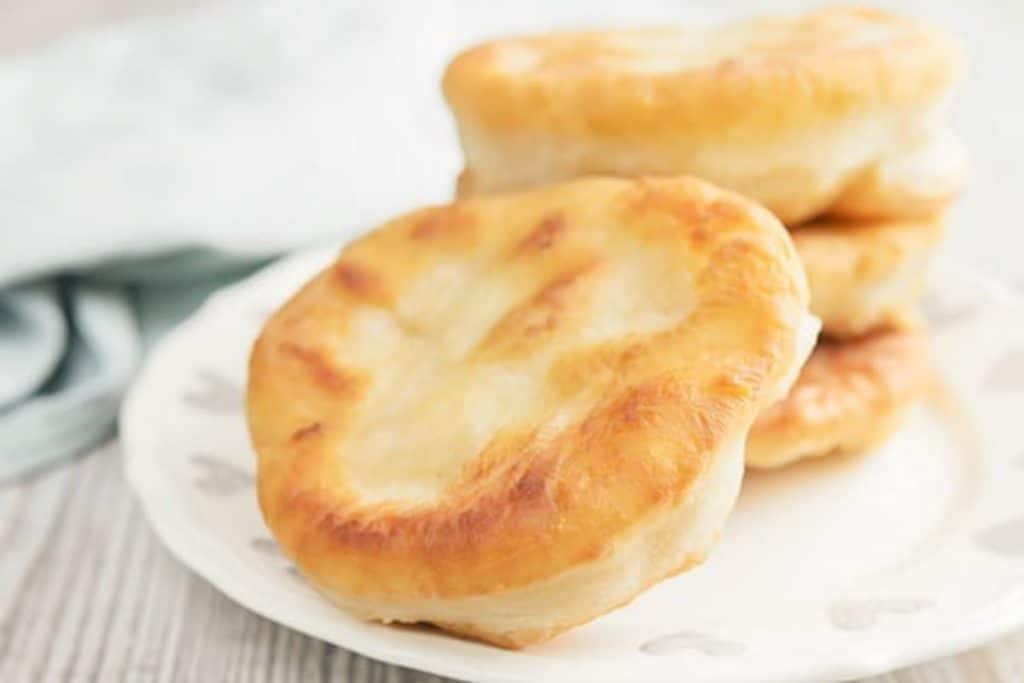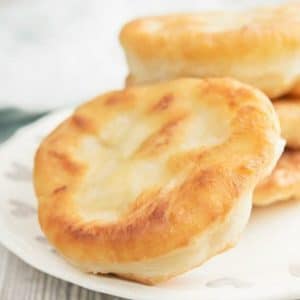Easy Bannock Bread
Bannock Bread is an easy skillet no yeast fried bread recipe. A traditional Scottish/Indigenous bread made with simple pantry ingredients. Perfect when a quick bread is required or even around the campfire!

I originally shared this recipe six years ago when Canada was celebrating 150 years.
I decided I had to include one of Canada’s Native Peoples recipes. Without getting into the political surrounding of our not so wonderful treatment of our First Nations, I would like to tell you a bit about the origin of Bannock, this simple fried bread.
Recipe Ingredients
- Flour – all purpose flour
- Baking powder
- Salt
- Oil – either olive oil or vegetable oil
- Water
- Vegetable oil for frying
As you see this type of bread has a leavening of baking powder and not yeast. Sometimes we get the urge for some bread but don’t have the time or the desire to wait for the rising time. Every now and then I like to make a No Yeast Pizza dough, or a delicious sandwich can be made with this Italian Flat Bread or why not an easy Irish Soda Bread?
How to make Bannock
In a large bowl whisk together the flour, salt and baking powder. Then add the olive oil and whisk together with a fork, gradually add water and stir until the mixture until it almost holds together.

Move to a lightly floured flat surface and gently knead about 10 times just until the dough comes together (the dough will be sticky, do not over knead).
Divide into 5 balls and flatten with the palm of your hand. In a frying pan or cast iron skillet, fry the bannock in hot oil (350F/175C)on medium heat (enough to cover the bottom of a medium frying pan), until golden brown on both sides (and cooked on the inside).
Drain on a paper towel lined plate and eat warm or at room temperature.

The Origin of Bannock Bread
Bannock an unleavened bread, was originally brought to North America by Scottish explorers and traders. Indigenous peoples in particular Métis adopted bannock in their cuisine in the eighteenth and nineteenth centuries probably after their encounters with Scottish fur traders.
As a result, even today many Métis and aboriginal western Canadians often prepare this dish. In western Canada, bannock is much more associated with native and Métis culture than with its Scottish roots.
Traditionally it was made with barley or oats, fat or lard and water. Then sugar and milk even buttermilk were added.
When to serve Bannock bread
With very few ingredients and easy to make Bannock is perfect as an accompaniment with a meal or even for Breakfast. It is often made when camping and it has been used as a staple food for wilderness explorers, trappers, and prospectors for centuries.

Tips for making the Best Bannock Bread
- Whisk the dry ingredients before adding the oil and water. I used olive oil but vegetable oil is more traditional.
- Bring the dough together with a fork.
- Move the Bannock dough to a lightly floured surface and knead only until the dough comes together.
- Do not over knead, this is not a yeast dough, and will be a little sticky, so therefore extra flour is not needed.
- Break off pieces of dough and flatten with the palm of your hand.
- Fry in hot oil on medium heat until golden brown and then turn to brown on the other side.
- Drain on paper towels.
- Eat warm or room temperature.
Can it be made with whole wheat flour?
Yes this bread can be made with whole wheat flour. It can also be baked rather than fried. Baked on a lightly oiled baking sheet in a pre-heated at 350F (180C) for 25 to 30 minutes.
Although baked Bannock is heavy and dense whereas fried is light and fluffy.
How to store Bannock
It is recommended to eat the bread as soon as it is made, this type of bread isn’t advised for storing.
I hope you decide to give this simple yeast free Bannock Bread a try and let me know what you think. Enjoy!


Easy Bannock Bread
Ingredients
- 2 cups all purpose flour
- 2 teaspoons baking powder
- ½ teaspoon salt
- 1 tablespoon olive oil or vegetable oil
- ¾ cup water
- vegetable oil for frying
Instructions
- In a large bowl whisk together the flour, salt and baking powder.
- Then add the olive oil and whisk together with a fork, gradually add water and stir until the dough almost holds together. Move to a lightly floured flat surface and gently knead about 10 times just until the dough comes together (the dough will be sticky, do not overknead).
- Divide into 5 balls and flatten with the palm of your hand. Fry in hot oil (350F/175C)on medium heat (enough to cover the bottom of a medium frying pan), until golden brown on both sides (and cooked on the inside). Drain on a paper towel lined plate and eat warm or at room temperature. Enjoy!
Notes
Nutrition
Updated from June 29, 2017.
how do you make it in a toaster oven? I can’t figure it out its doughy everytime
Hi Shawna, sorry but I have never made them in a toaster oven, I have only made them on the stove. Try baking it at 400F for about 15 minutes until golden brown. I hope this helps. Take care!
I’ve made this several times now and love it. It’s easy and fast, and doesn’t make too much.
Hi Roxann, thanks so much, so glad you like them. Take care!
Reminds me of when I was in Jr high and would spend weekends out at my friends place on the Blood Reserve. Tastes exactly how Mrs. Eagle Plume would make them, ensuring that there was some ready when we got off the bus. THANK YOU!!!
Hi B Traci, thanks so much, glad I could bring back memories! Take care!
My Grandson liked the crisp outside make it again nice soft texture inside its a keeper…
Thanks so much, so glad you grandson liked them. Take care.
I had to add a tablespoon of sugar, cuz that’s how my beautiful momma (RIP) taught me, but other than that, I tried this recipe and it turned out great. I used the 4 cup recipe. I made a few larger pieces for hamburgers, and then used the rest to make small pieces. Nice and fluffy and crispy.
Hi Shelley, thanks so much, so glad you enjoyed it and sorry about your Mom. Take care.
CORRECTION: USE 1/2 tsp baking soda not 1 tsp.
I use baking soda 1 tsp and less than 1tbsp vinegar for each 2 cup flour
I’ve been thinking about trying to make bannock and came across your site today. It was intriguing because you highlighted Canada which is where I live and the Scottish connection which is part of my roots. Have it a try and would like some advice. My husband loved it but I found the oil taste a bit strong. I might be able to figure out how to adjust that but if you have tips, that’d be great.
My dough however was the issue. It was not moist but rather dry and flaky like tea biscuit dough. I tried to add some extra water but it didn’t mix in well so I towelled some of it off. End result did not look like yours and I know I must have done something wrong in the dough. If you have advice, I’d appreciate it. Would love to try this recipe again.
Hi Ruth, try using a light vegetable oil. The dough shouldn’t be dry (as seen in the video), add a little more water to make it wetter. Sometimes the type of flour can make a dough drier or wetter. Let me know how it goes.
Hi, I know this bread isn’t meant to be stored but would it still taste good and have the same texture/consistency if served the next day? My son’s class is reading The Door in the Wall and they mention bannock. I’d love to make some and share with the class but I wouldn’t be able to make it and serve it on the same day. Thanks!
Hi Michelle, it should keep ok for a day or two in an airtight bag or container at room temperature. Let me know how it goes.
I just made these for my family, they said that they were great. Thank you for this great recipe, definitely going to make these again.
Thanks Alex, glad everyone enjoyed them. Have a great weekend.
Is there anything you can substitute the baking powder for?
Thanks
Hi Paige, you can substitute it with baking soda, but only use 1/2 teaspoon. Hope that helps.
Hey – Are the nutrition facts per serving or for the entire loaf? thanks!
Hi Eric, it’s per serving, it might not be 100% accurate as it is part of the recipe card.
So I needed something quick. I think it’s my first fry bread try. I did half unbleached flour, half fresh ground wheat. The whole family enjoying as I type. The fresh ground wheat made it heavy (as expected ( next time I’ll divide into 6 and flatten a bit more). I made it a cast iron skillet and it works great!
Thanks Angel, so glad everyone enjoyed it. Have a great week.
I love these recipes! Delicious, easy to follow, and hearty. Thank you!
Hi Hanan, thanks so much, so glad you like it. Have a great week.
Would this work with almond flour or rice or tapioca flour.? I ‘m allergic to gluten but love the taste of bread so I use alternative flours or seeds flour.
Hi Tom, I really don’t know I have never made it with almond or tapioca flour, you could try and let me know. It might since it doesn’t have to rise or bake.
Hi Tom!
Chickpea flour might work as a replacement, though you’ll want to make sure to use hot (not boiling) water when you make the batter.
Ratios may be a bit different, so just be aware of the texture!
I use chickpea flour for my bannock as I developed a wheat intolerance, and it is just as good as the bannock I grew up with 🙂
(p.s. chickpeas flour = garbanzo bean flour if you’re from the states!)